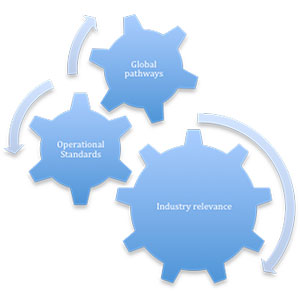 Vocational education has been around for centuries, the ability to master some traditional trades has been passed from generation to generation in pioneer versions of vocational education and training (VET) systems, since the very beginning of our societies.
Vocational education has been around for centuries, the ability to master some traditional trades has been passed from generation to generation in pioneer versions of vocational education and training (VET) systems, since the very beginning of our societies.
The application of the same VET concepts in modern economies is a powerful tool for organisations and governments to produce key benefits for industry and individuals, stimulating local economies and promoting an even playing field for social inclusion.
The practical nature of VET provides an extended definition of value to learning outcomes. The expectations of vocational education programs are linked not only to meeting learners' needs, but also industry's needs. This extended definition of value allows us also to set objectives for a vocational education program at five different levels:
- Reactions
- Learning
- Application
- Impact
- Return on Investment (ROI)
The dynamics of these five dimensions of value, are critical for vocational training practitioners to connect individual needs with industry needs, and from a national perspective, to set strategic directions to develop individuals and the economy in harmony with social goals.
For a VET system to work effectively, the environment where it is applied (country, community, organisation) must present the following conditions:
- Industry relevance
- Operational Standards
- Global pathways.
Industry relevance of VET means that learning objectives of every training program must address standard industry practices. The skills and knowledge learners will learn during the training, must provide them with the ability to perform the tasks of a competent worker within a particular job role. Operational standards refer to the accountability of training providers within the system, in regards to the results of training, measured at the five dimensions of value. Finally, global pathways refer to the recognition and use of VET qualifications within the formal education system (including the school and higher education system).
Adopting a competency-based model
To ensure all stakeholders will receive the benefits of VET it is imperative that industry, government, training providers, content developers and students adopt a common model to specify learning objectives. The competency-based model works as a framework for stakeholders to set, communicate, apply, and evaluate the objectives, and impact of VET qualifications.
Industry uses competency standards to describe the attitudes, skills and knowledge of a competent person.
The accountability factor
During the design of vocational training, a critical process that must take place during an extensive consultation with the industry and learners is the definition of program objectives at the different dimensions of value. Training program objectives are linked to the needs assessment. Note that the dimensions of value have been aligned with the evaluation levels from the ROI Methodology. The current Australian regulatory framework has set minimum compliance requirements up to level 3 (Application). RTOs are encouraged to define objectives and evaluate training to levels 4 and 5 (Impact, and ROI).
Competencies are the link
Competencies are the critical link between learning and its application in the workplace. It is critical that competencies are used as the common measure for all stakeholders. Within the Australian system, the units of competency provide that link, working as the fundamental measure of competency.
New Language
The competency-based model jargon is also new for potential and current learners. The government needs to invest in an informative marketing campaign dedicated to educate learners and the community in general in the objectives, processes, and outcomes of VET, if we are to exploit the system to its maximum capacity.
Students and the community need to understand the benefits of VET in all its dimensions. How VET can support their lifelong learning, how VET can serve as a bridge for employment and further studies.
This is important not only so students are able to understand core VET concepts, but also to understand the application of VET courses.
Conclusion
In a results-driven economy with continuous and radical changes in workplace practices, Vocational Education and Training's value can be re-defined to meet the needs of learners, industry and communities.
A VET system can supply "job ready graduates" to industry, can provide a career pathway for learners, an alternative but convergent route to education embedded into the higher education system. VET can deliver the "just-in-time" "work-integrated" learning required by employers, can address gaps in strategic skills identified by the government, but for this to happen we need certain conditions to promote an even playing field.
Those conditions require a balance between three main areas:
- Industry relevance
- Operational Standards
- Global pathways.
Maintaining the balance between these areas will ensure all stakeholders will benefit from the system. When there is an unbalanced mix in the system some stakeholders can obtain circumstantial benefits but the system loses credibility and generally is abandoned. In my experience, the same principle applies to VET systems used at organisational levels, nation wide or even on an international scale.




